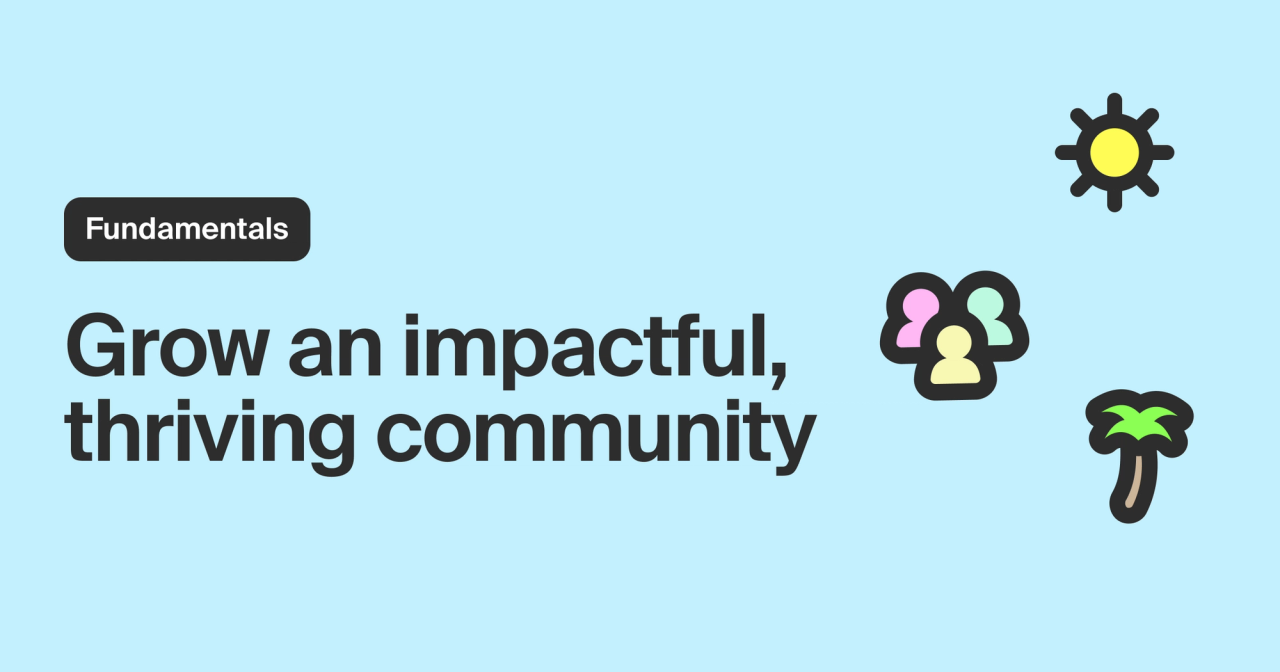Community initiatives center on our desire to feel connected as humans. Engaging with users and prospects in a two-way dialog—rather than a one-way communication—opens up countless opportunities for connection.
Traditional marketing and sales tactics are largely one-way channels: organizations disseminate information to an ‘audience’ via something like an email marking campaign and expect viewers to consume branded content without responding or contributing to the conversation.
In a community, everyone is empowered to interact and share. Users, champions, influencers, prospects, and all other members take part in sharing experiences, product help, tips, and more—alongside representatives from a company that facilitate or participate in the community. This post will cover the best practices for growing your community to achieve key metrics. These best practices put your company in a position to increase user acquisition, user retention, and referrals, and improve ROI across other marketing and sales initiatives.
Why building a community matters now more than ever
It’s the age of interconnectedness. We’re constantly communicating through always-on digital pathways in our personal and professional lives.
As people spend more and more time online and across a variety of digital channels, businesses need to take advantage of new engagement tactics and expand beyond traditional marketing and sales strategies.
An omnichannel community approach allows companies to meet their current and prospective users where they are: on digital channels like Slack, Discord, Discourse, GitHub, Twitter, and more.
The benefits of community engagement are far-reaching and long-lasting. Community engagement can drive higher user retention, increased referrals, more user acquisition, and greater ROI. These metrics contribute to meaningful bottom-line impact for companies.
Moreover, neglecting to engage in community initiatives can have negative consequences. Communities provide a wealth of information about product and brand sentiment and customer satisfaction. You don’t want to miss these insights that can help your company create products that customers love, while also unearthing upsell opportunities (or opportunities to prevent churn).
Communities also drive product and brand loyalty. If you don’t nurture your community, you open the door for other companies to form relationships with your prospective customers.
That’s the catch-22 of our always-on digital reality—choosing not to engage means your business will miss out on a lot of value in both the near and long term.
Best practices and tactics for growing a community
To build a vibrant community that creates real growth opportunities for your members and business, it’s crucial to do the following:
- Understand who you’re building for
- Set expectations and community standards at onboarding
- Encourage engagement and member-to-member interaction
- Identify and support your most influential members
- Automate community management tasks to scale engagement
- Use intelligent tools to measure, track, and analyze impact
Understand who you’re building for
Ultimately, your community is comprised of people—each with their own preferences, idiosyncrasies, expectations, and goals. Understanding the concerns, aspirations, and desires of your specific community members will help you and your organization build the right kind of space and foster the right kind of engagement. Your sales and marketing teams should also be able to provide insight into the personas they’re targeting in order to create truly effective collateral. As you get to know individual members, community managers must similarly analyze and validate these personas to inform a community strategy.
There are many different community members you may want to engage, including existing customers, prospects, or influencers within your specific space.
Spend time researching communities similar to the one you hope to build. Looking at competitors’ efforts may be helpful here. Then, based on your research, your product, and the goals of your community marketing team, decide whether it’s best to launch a community of product or a community of practice.
- Community of product: Communities of product center on a company and their specific offerings. These communities are about helping community members use the company’s product in new and innovative ways.
- Community of practice: A community of practice is built around people who come together to improve a skillset, advance their knowledge base, or work towards a common goal—often, this goal is a professional aspiration.
Decide which kind of community is right for you based on the portrait you build of your ideal community members.
Set expectations and community standards at onboarding
To grow your community effectively, it’s important to set the tone and establish expectations from the outset. Community leaders can do this efficiently by:
- Creating and posting a community code of conduct
- Establishing a process for approving new members
- Implementing consistent, enforceable guidelines
- Deciding which topics your community will be devoted to
Creating and posting a community code of conduct
A code of conduct sets expectations for acceptable behavior helps to simplify the moderation process and ensures all members are aware of the group’s general guidelines. In a code of conduct, community leaders can address areas such as privacy, message retention, harassment, reporting, and consequences for disobeying the code of conduct.
Establish a process for approving new members
As a community leader, you get to decide how exclusive your community will be. Slack communities, for example, can be invite-only, so moderators control who gets approved and who doesn’t. Be intentional about whether your community will be open or closed and how you’ll approve new members.
Implement consistent, enforceable guidelines
Moderation is key to maintaining order within your community. Leveraging chatbots is a great way to put moderation on autopilot where you can. Community moderators can configure bots to flag inappropriate words or phrases to ensure members are always treated with a baseline level of respect.
Decide which topics your community will be devoted to
This selection curates a general theme for your community. The topics you choose will dictate not only what the group discusses, but what the group is known for. The number and breadth of topics and subtopics you choose will also help dictate which communication platform you choose, based on the UX and channel/thread capabilities. Consider both your target audience and the goals of your company when deciding on topics.
Community leaders can implement these best practices from the very beginning to streamline moderation and focus the community on a discrete set of subjects and themes.
Encourage engagement and member-to-member interaction
Again, communities are not a one-way channel. Fostering interactions between members is just as important as being an active moderator and contributor. Encouraging members to interact with each other directly is key to nurturing a vibrant community where members feel a sense of belonging and camaraderie. Ultimately, this sense of belonging is one of the main reasons members join in the first place (and stay).
Choosing a platform that enables users to message each other directly ensures members can build real relationships with each other.
Setting up automated workflows or prompts that remind members to introduce themselves, engage with other members, share content, or answer each other’s questions helps to increase user-to-user engagement as well.
Without active members, your community will languish. Growth across any metric will not be possible. Knowing how and when to spur engagement within your community keeps the group from becoming stale.
Holding regular events, rewarding brand champions with insider access or swag, and ensuring moderators answer questions promptly keep your community active and healthy.
Monitoring community engagement levels through an intelligent community growth platform can help community moderators spot notable decreases in engagement. With this data, community managers can send automated or personalized messages to users to stimulate engagement or send relevant resources to users to spark conversation.
Identify and support your most influential members
Using an intelligent community growth platform, you can easily track which members of your community have the greatest impact, highest level of engagement, and most significant contributions to the community at large.
These community members are invaluable. They’re your brand evangelists, product champions, or super-users, depending on the kind of content they share and the kind of community you’ve built.
Acknowledging superusers encourages them to keep posting and replying frequently. There are many ways to do this—some companies give community members who create content relevant to the community a certification.
Salesforce’s Trailblazers program is a great example. Trailblazers are Salesforce users and community members who do innovative things with the platform and share their innovations with other users. Trailblazers receive a Trailblazer hoodie from Salesforce as a thank-you for their contributions.
Some organizations establish ambassador programs. As a thank-you for their leadership in the community, ambassadors are offered exclusive insights and early access to new product features. They often also get career growth opportunities like speaker slots or invites to networking events.
Automate community management tasks to scale engagement
The platform where you choose to host your community may offer features that allow moderators to send automated messages to users (like Discord Bots). This automation makes moderating large communities a lot easier.
As your community grows, leveraging automation becomes increasingly important. Moderators can only send so many manual messages in a day—automation will help your team scale.
An intelligent community growth platform can help automate actions across all community channels to scale engagement without losing that human touch. Common Room offers workflows, a set of automations allowing community moderators to set up welcome messages as part of onboarding workflows, re-engagement messages for users that have recently become less active, or survey questions for members based on their recent replies.
Use intelligent tools to measure, track, and analyze impact
In addition to moderating the community, community leaders are also tasked with proving the ROI of their efforts to their larger marketing and sales teams. Each individual community channel has tools that track and report on their own metrics, but they provide a limited view of your community as a whole.
With an intelligent community growth platform, you can measure the success of your community across channels and demonstrate the holistic value of your community initiatives. Common Room is capable of bringing together insights from across a variety of community-hosting platforms—including Discord, Slack, Discourse, LinkedIn, and others—to equip you with engagement metrics to help ideate strategies for future community growth. Common Room also connects that data to your CRM, so you can assign real business value to community happenings and track KPIs related to referrals, user acquisition, and user retention.
Common Room can help you scale sustainably
Common Room gives companies real-time intelligence, context, workflow automation, and data insights to accelerate community growth against measurable goals.
The platform pairs machine learning-powered insights with engagement and reporting tools to help community managers build, manage, and measure fast-growing communities.
Leverage automated workflows to deliver messages to specific users at the right time, customize automated reporting to keep track of your community’s health and identify areas for growth, and track the topics, discussions, and activities that are most impactful in your community.
These insights and automated actions empower community leaders to scale their community initiatives efficiently and sustainably. If you’re in the early inning of your community and looking for more resources, check out Common Room’s library on seeding your community.
If you’re ready to get started with Common Room, try the platform for free today or request a demo.

